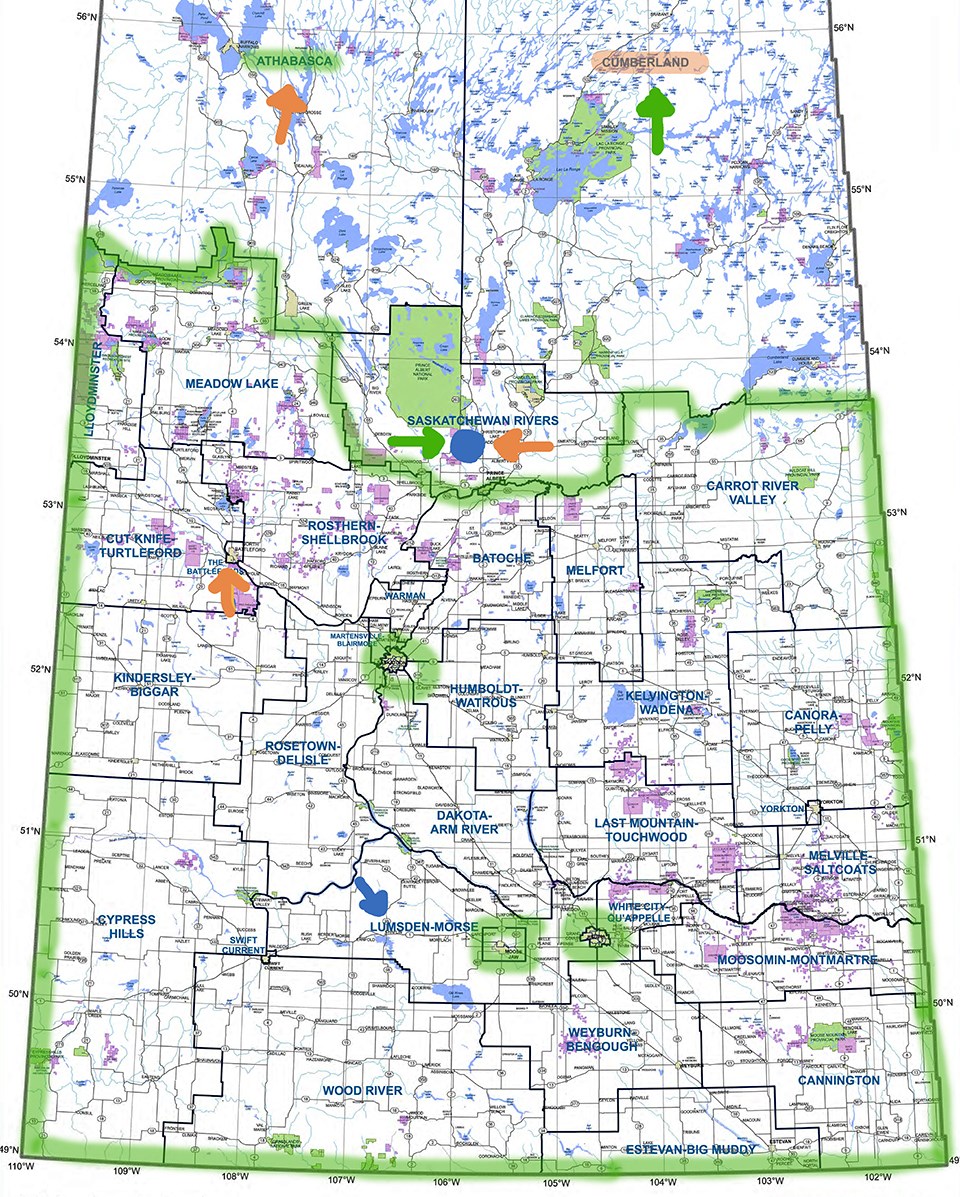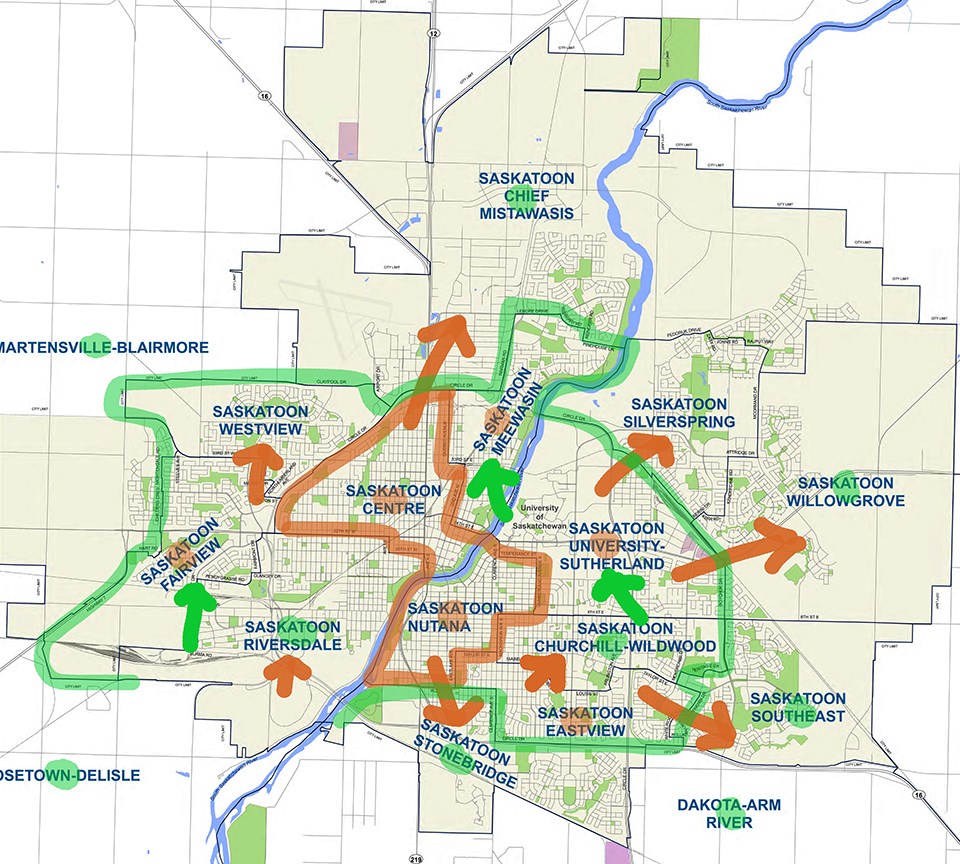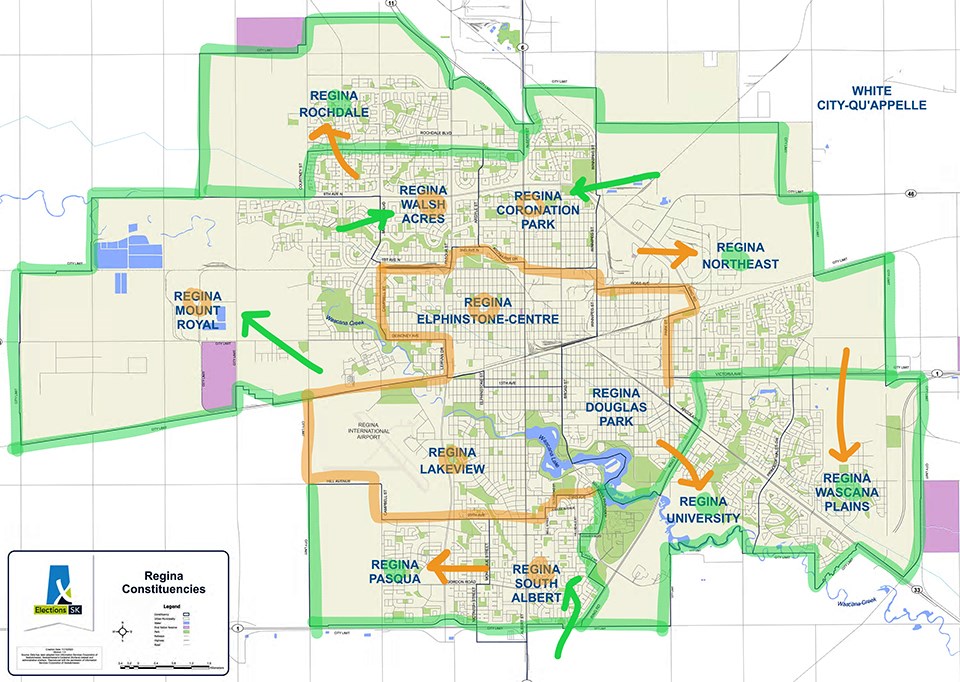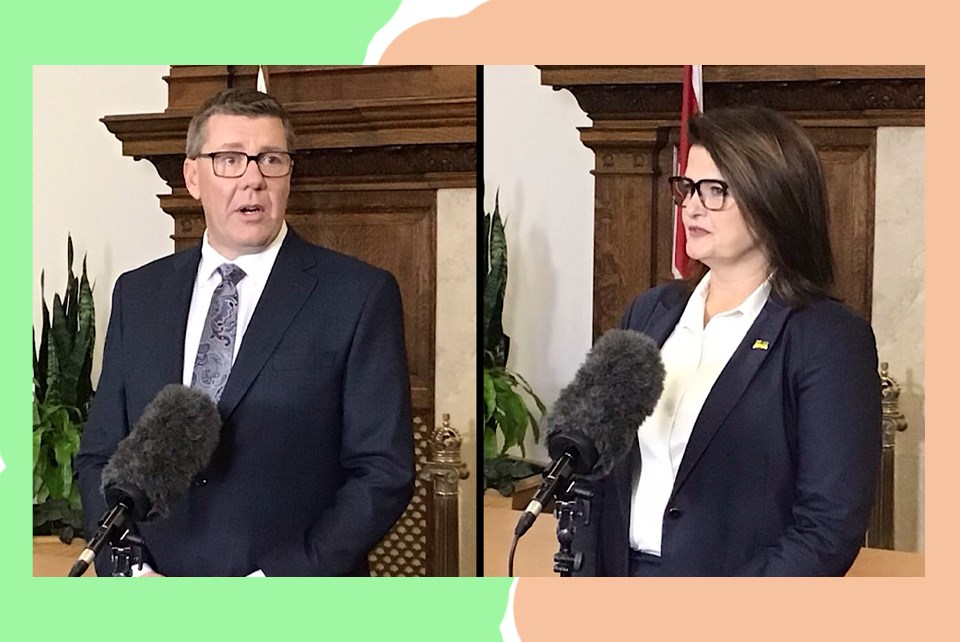REGINA - Today, I am going to lay out for you the battlegrounds in this provincial election campaign, and the path for each of the political parties to win a majority government.
My inspiration for this article is really from watching the American political coverage and all the talk about the “road to 270” electoral votes for each of the candidates for president.
In that coverage, they look at which states are “in play,” meaning close races, or “not in play,” meaning states that are pretty much decided one way or another. And then they figure out what remaining states the candidates would need as a pathway to 270 out of the 538 electoral votes required in the Electoral College to win the election and become President.
I’m going to do the same thing here, at the provincial level, with Saskatchewan’s 61 electoral districts. Here, the path is to the magic number of 31 seats in the legislature for a majority government. That means that to win a majority outright, one party needs to hold all the opposing parties to 30 seats or less.
I’m now going to lay out the “pathway to 31” for both Scott Moe’s Saskatchewan Party and Carla Beck’s New Democrats, in a way that will hopefully be easy to understand and in a way that will give you a good idea of what to watch out for on Election Night. As part of this deep dive I’ve added some “war maps” to illustrate which ridings are 小蓝视频 targeted by which party.
This analysis is based on what we already know from the latest polling — Janet Brown has the Saskatchewan Party up by five points and Mario Canseco’s Research Co. has them up eight points, while Insightrix is giving the NDP a five-point lead. It's also based on the itineraries of the various parties from the past few weeks which has targeted ridings in the four largest cities in particular. It also takes into account my analysis of results from the last election and previous elections before that.
So, we will begin with the results of the last election: Saskatchewan Party 48, the NDP 13. In the last few years due to defections, resignations, deaths, by-election losses and people leaving the caucus to sit as Independents, the Sask Party total at dissolution has dropped down to 42, and the NDP has moved up to 14.
These numbers alone tells you the magnitude of how far the NDP must climb to get to 31 seats. To win the election the NDP have to win 17 additional seats, and they must find those seats anywhere they can get them.
For the Saskatchewan Party the pathway to 31 is simple. All they need to do is simply hold the ridings they already have, or avoid dropping under the magic number of 31. So from our perspective, and to make it easier, let’s concentrate on the NDP and that starting point of 14.
To figure out how the NDP will manage to get to the magic number of 31, we start by looking at the electoral map and crossing off the ridings where the NDP is, already, likely to be out of contention.

The Rural Firewall
The Saskatchewan Party has a massive advantage in every seat located south of the three most northern ridings Athabasca, Cumberland and Saskatchewan Rivers, and outside the four largest cities Saskatoon, Regina, Prince Albert and Moose Jaw. These ridings are the bedrock of the Saskatchewan Party’s rural base. They range from Scott Moe’s seat of Rosthern-Shellbrook, to Colleen Young’s seat of Lloydminster, down to the southwest including seats like Everett Hindley in Swift Current, to oil country in the southeast including the cities of Estevan and Weyburn, and up through the parkland and into the northeast. It also includes the seats bordering on the major cities such as Martensville-Blairmore and Warman.
These are ridings the Saskatchewan Party has won with vote totals in the high 60 per cent range up into the 80s. What's more, many of these seats have a history of been won by the Sask Party, or by the "free enterprise" parties like the Progressive Conservatives or Liberals, for decades.
In the old days, the Liberals’ bedrock ridings used to form an “L” on the map extending across the entire west and south of the provincial map. That Liberal “L” eventually became a Conservative "L" and now a Sask Party “L.” Except nowadays, the Sask Party bedrocks also include the central and the east, including former NDP ridings that at one point in time were called “Red Square” because they were so reliably socialist. But that is a distant memory now, because those ridings are now Sask Party, too.
So the Sask Party "L" is really more like a big chunk of green cheese. It covers basically the entire rural southern half of the province. I call all of these seats — all 28 of them — the “Great Sask Party Rural Firewall.” This narrows the pathway for the NDP dramatically.
The best way for the NDP to win would be to blow up this firewall in similar fashion to what Roy Romanow did in 1991, when he decimated the Grant Devine PCs and took down their rural "firewall". Unless something changes, though, there is little sign of this happening. Among other things, the NDP leader’s tour hasn’t bothered to show up in most of the rural seats the whole campaign.
That leads me to think the rural firewall is holding up. Having said that, there are cracks appearing, and I will come back to this later on.
The orange wall
Now we turn to the seats that are part of the NDP’s traditional base. They include the urban bedrocks such as Carla Beck’s seat of Regina Lakeview, Meara Conway’s seat of Regina Elphinstone-Centre, and Nicole Sarauer's seat of Regina Douglas Park. Add to that the Saskatoon strongholds like Saskatoon Centre and Saskatoon Nutana.
These ridings represent the NDP’s “Orange Firewall," and there's a heck of a lot fewer seats in the NDP's firewall than in the Sask Party rural firewall. I'm tempted to also include longtime northern seat of Cumberland which has been NDP forever, except this time they don't have an incumbent running with the departure of Doyle Vermette.
Having said that, if the current polling is to be believed, the NDP ought to win the 14 seats they currently hold, and I'd say folks like Trent Wotherspoon and Vicki Mowat will have little to worry about on election night. It goes without saying these are "must wins" if the NDP hopes to form government. The seats where they are most vulnerable in Regina, are the two seats they picked up in byelections in Walsh Acres and Coronation Park, and Aleana Young in Regina 小蓝视频 Albert. In the last election Young won by a little over 300 votes. If this election is at all like the last three, Young could be in a fight. But if the NDP makes their big gains as predicted, she should be okay.
So let’s start with these 14 seats as a basis point for the NDP. Where do the NDP look for gains behind this to get to 31?
Target number one: taking back Athabasca.
Athabasca played a pivotal role in shaking up the Saskatchewan political scene this term. This was long a stronghold for the NDP when it was held by Buckley Belanger, but then he resigned to run federally. And then the unthinkable happened: the Sask Party's Jim Lemaigre won the byelection by over a thousand votes in 2022. That prompted Ryan Meili to resign as leader, paving the way for Beck to take over.
So the first order of business for the NDP is to take back Athabasca. They're running Leroy Laliberte there against Lemaigre, and if the history of the riding is any indication, this seat is prime to swing back.
That would put the NDP at 15 seats. And now, we turn to the urban battleground ridings.
The urban battlegrounds
You can tell a lot about how the election is going and where the battleground ridings are by looking at the itineraries of the party leaders. In this election campaign, Scott Moe and Carla Beck have been spending most of their time in four specific areas: Saskatoon, Regina, Prince Albert, and Moose Jaw. In fact, Moe called the election and launched his campaign in Saskatoon, which tells you a lot of how important that city is to the campaign.
These cities produced some of the closest races in the province in 2020, and it's these seats the NDP must win. Saskatoon Riversdale, a former NDP stronghold held by former Premiers Roy Romanow and Lorne Calvert, narrowly went to the Sask Party in 2020. Now the incumbent isn't running again, which makes this a prime target for the NDP.

Another target: Saskatoon Churchill Wildwood, where Lisa Lambert barely won in 2020 and is in big danger of losing re-election. It will be tougher to knock off David Buckingham in Saskatoon Westview, but based on current polling, he's also in the danger zone.
In Regina, the usually razor-tight Regina Pasqua was won by the Sask Party’s Muhammad Fiaz by a narrow margin last time. Meanwhile, the NDP has openly targeted Regina Northeast, formerly held by Gary Grewal who most recently was found to have violated the Conflict of Interest Act. That ruling did the Sask Party no favours whatsoever. They're in tough to hold either seat.

Then you have Moose Jaw Wakamow, where incumbent Greg Lawrence isn't running again and facing criminal charges.
The Sask Party also has a fight on its hands in both Prince Albert seats. There's no incumbent in Prince Albert Carlton with Joe Hargrave leaving, while in Northcote Alana Ross barely won last time over Nicole Rancourt. This time Rancourt has returned to try and take her seat back.
Maybe the Sask Party can save Prince Albert Carlton - Scott Moe has visited the riding countless times to try and keep the seat. Or maybe they save Saskatoon Westview. Some of the models I’ve seen have Buckingham keeping his seat. In any event, if the NDP hope to form government, they need to flip each and every one of these eight targeted seats.
Can they do it? Yes.
If they do it, it would put the NDP at 23 seats, leaving them only eight seats short of majority government.
And that might be as far as they get.
The Sask Party urban firewall
In Saskatoon, the five remaining Saskatoon ridings - Chief Mistawasis, Willowgrove, Silverspring, 小蓝视频east, and Stonebridge – are the strongest areas of Saskatoon for the Saskatchewan Party. Most of these areas have been held by the Sask Party since their urban breakthrough in 2003 and in the case of Stonebridge, Bronwyn Eyre racked up the largest margin of victory of any Sask Party candidate in the city of Saskatoon in the last election.
In Regina, we have the seats of Regina Rochdale, held by Laura Ross, Regina University where Gene Makowsky is seeking reelection, and Regina Wascana Plains which has been held for years by Christine Tell. Similarly, these three are the strongest areas of town in Regina for the Sask Party.
Add to that Moose Jaw North, held by Tim McLeod, and together these nine seats make up the Sask Party's “urban firewall.”
These are ridings where the Sask Party candidates won by 1,500 votes or more in the last election. The challenge for the NDP is daunting; they need to win eight out of nine “firewall” seats to form a majority government for a near-total urban NDP sweep.
History shows it can be done, sweeping all but one of the seats in the four largest cities, but it hasn’t happened in a long, long time. The last NDP leader to do it was Roy Romanow in 1999 — and he didn’t even win a majority that year.
The NDP have no choice but to target these seats, which is exactly what they are doing. What the NDP needs to accomplish is something along the lines of the epic rural-urban splits that we saw in the 1999 and 2003 elections, with the kind of urban sweeps that allowed the NDP to barely hang on to power. Some pundits think this scenario could happen again.
Can the NDP scale the urban firewall? Maybe.
The problem for the Sask Party is that their Regina firewall isn't that much of a firewall. In Rochdale and University the margins last time were under 2000 votes. Makowsky's riding has been completely redrawn and the NDP have put up star candidate Sally Housser to try to knock him off. The one thing that might save Makowsky and Ross is that they're both personally popular.
The one piece of good news for the Saskatchewan Party in all of Regina is that Christine Tell won last time by almost 3,600 votes. For the NDP, that’s a huge boulder on the road to a majority.
In Saskatoon, there are some cracks in the firewall as well. Both the Chief Mistawasis riding and the 小蓝视频east riding were held for years by Sask Party stalwarts Gord Wyant and Don Morgan. They aren't on the ballot this time, and with no Sask Party incumbents that makes both seats more vulnerable to a swing to the NDP.
The problem here for the NDP is that these seats have both voted Sask Party for over 20 years. “It’s time for change?” That’s what the NDP has to hope for here.
Saskatoon Silverspring is the riding of Minister of Corrections, Policing and Public Safety Paul Merriman, and on the surface he looks like the one cabinet minister most vulnerable to a swing to the NDP. He won last time by about 1,500. Besides that, the NDP and the National Police Federation have been blasting the Sask Party’s plans for the Marshal’s service to no end. If only one cabinet minister goes down in this election, my bet is it’s probably him.
But this area has also been Sask Party for over two decades.
In Stonebridge, incumbent Bronwyn Eyre’s riding has been totally redrawn so that the “Dakota” portion has been taken out and placed in Dakota - Arm River. That’s a ton of Sask Party voters, part of her massive majority last time, now living in a different riding and voting for someone else.
That leaves Willowgrove, where Ken Cheveldayoff took this riding in 2020 by almost 4,000 votes.
I find it hard to believe that the NDP can take out Cheveldayoff. I think it would be a stretch to even take Eyre out. I know the NDP have also been targeting Tim McLeod in Moose Jaw North and saying all kinds of awful things about his time as Rural and Remote Health minister, but his margin last time was 2,201. That will take a major swing to overturn.
In short, the NDP has to find a way to win eight of these nine ridings — all held in the last House by sitting cabinet ministers or former ones, all elected by wide margins (massive in some cases), in areas that have voted Sask Party for years.
I’m not saying the NDP are going to lose all of these seats. What I am saying is that if they do crack the “wall” and take out big names like McLeod or Merriman or Eyre, it will be a major story. It will be indicative of a very bad night unfolding for the Sask Party.
It also underscores the narrow path to victory for the NDP. To get to 31 seats, they have to blow this urban firewall up. Almost the entire thing.
It looks like Mission: Impossible, but strange things do happen in politics. Roy Romanow did lose his seat in 1982.
By the way -- if the most recent Insightrix poll is to be believed, the one that has the NDP up five points, then they're definitely blowing up the urban firewall. There would be no Sask Party incumbent in the cities safe under that poll. We'll see what happens.
Expanding the map
Let’s say the NDP falls short after all of this and only manage to get to 28 seats.
In that event, the NDP would need to “expand the map,” using a phrase from US presidential politics, to get to 31. They would have no choice, then, but to crack holes in the “Saskatchewan Party rural firewall” that we talked about earlier, in order to take power.
And that brings us to The Battlefords.
Theoretically, this riding falls within the rural firewall. Jeremy Cockrill won here in 2020 with a massive 66 per cent of the vote, after Herb Cox won convincingly the previous two times.
But the electoral history of this area is something else — it’s changed hands between multiple parties so many times it makes your head spin. Over the years, it’s changed hands from the NDP to the PCs, back to the NDP and then to the Liberals and then back to the NDP again, up until Len Taylor was defeated in 2011. And the Battleford portion at one point split off and was Sask Party for a while, and… well, you get the idea.
Moreover, Cockrill has faced an absolute pressure cooker in the Education portfolio, having to deal with a labour dispute and all the other controversies, including the “pronouns” legislation stuff. Plus, he’s 小蓝视频 accused of conflict of interest.
The NDP has been sending their people up to The Battlefords in an all-out effort to knock Cockrill off and elect local teacher Tom Kroczynski, so this is definitely a target seat. If they want to scale the Rural Firewall, this is their best, perhaps their only shot.
But what if Cockrill wins?
Then the NDP must look north to Meadow Lake, also part of the rural firewall, but here the task is even more daunting as incumbent Jeremy Harrison got 71 per cent of the vote last time.
You would think the NDP has no hope here. But Harrison has had no shortage of controversies regarding his interactions as House Leader with the Speaker, Randy Weekes. The NDP made the most out of revelations that Harrison took a rifle into the Legislature years ago. Whether voters feel inclined to give him the boot is another story entirely.
So, what if Harrison wins, too?
In that case the NDP needs a miracle. They would have to hope to win in a place like Yorkton, which used to be a swing seat at one point in time but not lately. Mind you, there are folks out there who think the NDP stands a chance in Yorkton. I still think an NDP win there would be an upset.
The other possibility are the ridings bordering on the major cities such as Martensville-Blairmore, Warman, or White City-Qu’Appelle — which unfortunately for the NDP are three areas that have been Sask Party bedrock for years.
If the NDP are winning in these places, they probably already hit their 31 seats for a majority. These look more like potential "bonus" seats to me.
The blue wall
That brings us, finally, to two remaining rural ridings that could potentially wreak total havoc over this 2024 provincial election: Saskatchewan Rivers and Lumsden-Morse.
The reason is summed up by the following words: Saskatchewan United Party. They are truly the wild card in this poker game.
Saskatchewan Rivers, located in the rural areas outside Prince Albert, is currently held by Nadine Wilson, the ex-Sask Party 小蓝视频 who left caucus some time ago and became the lone 小蓝视频 for this populist and true-conservative party. The Saskatchewan Party is trying to take it back with Eric Schmalz, and they may do it. But incumbency is the one advantage Wilson has in her favour.
The other factor is what happened during the 2003 election. In that vote, Saskatchewan Rivers swung to the NDP, and in doing so handed them their majority — 30 seats to 28.
For that reason alone, this riding should be left out of the “Sask Party rural firewall.” If the NDP are still short of a majority by this point, then this is literally their last hope.
And with Wilson now seeking re-election for Sask United, it’s not even a Sask Party-held seat anymore. Instead, it’s become their number one target — one the Sask Party must flip back to their side to secure their majority.
It all comes down to Lumsden-Morse, where Sask United leader Jon Hromek is trying once again to beat the Sask Party’s Blaine McLeod, who won the byelection last year by around 30 percentage points.
This seat is in my list of 28 “Great Sask Party Rural Firewall” seats, and for good reason: it is as conservative as it gets. It was an area held at one point by Ross Thatcher, the last Liberal Premier of Saskatchewan, and it was solidly held by the late Lyle Stewart for years for the Sask Party.
I have to believe McLeod still has the advantage, it would take a huge swing to knock him off. But he’s facing in Hromek a party leader who is better known now than during the byelection. This seat is Sask United’s prime target (as opposed to Wilson 小蓝视频 their prime defence). It was ground zero for all the controversy last year about Planned Parenthood’s sex ed materials in schools. And this riding is already so philosophically conservative that you can imagine it might just go for Hromek.
For these reasons, all bets are off. If you don’t believe me, just drive into that riding and check out all of the blue signs Hromek has up.
Sask United has no chance at winning the election; they are only fielding candidates in 31 ridings and their advertising spending is a pittance. But they have the potential to cause big problems as a spoiler in a number of close races. Among other things, Sask United have a candidate running in Regina Wascana Plains who could potentially split off enough votes to potentially cost Christine Tell her seat.
The last word
I may have the recent B.C. election on the brain, but think of this:
We could, possibly, have a scenario where if all the numbers break just right, it could end up 小蓝视频 30 seats for the Sask Party, 30 for the NDP and one for Sask United!
If that happens, all heck would break loose in the province of Saskatchewan. Lieutenant Governor Russ Mirasty would definitely be earning his paycheque figuring all this out.
That’s not at all my official prediction, but it is fun to think about.
To sum up:
For the Sask Party to get to 31, they need the rural firewall to hold, and enough of the urban firewall. If that happens, they win -- even if they drop a lot of other seats elsewhere.
For the NDP, they must hold their 14 seats, take back Athabasca, take the eight urban battleground seats, and then blow up the Sask Party urban firewall. And maybe add The Battlefords just for insurance.
And for the Sask United, they have no hope of winning the election, but if they can take either Saskatchewan Rivers or Lumsden-Morse, or both, maybe they get the balance of power.
That's it! See you on Election Night.






